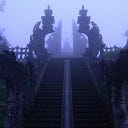The Padmasana Shrines in Bali
Originally posted on Indosphere.co
A Padmasana is the Indonesian Hindu shrine to worship God (Ida Sang Hyang Widhi Wasa), or Shiva. The Padmasana is a symbol and image of the macrocosm or universe (Bhuana Agung), as described in the lontar scripture Dwijendra Tattwa, written by Danghyang Nirartha, the last major reformer of the Shiva-Buddha religion, who arrived in Bali from Java after the fall of the Majapahit empire.
Danghyang Nirartha established the Padmasana as a shrine to worship God (Parama Shiva), both in horizontal and vertical form (as both the Material Universe and the Universal Consciousness).
Padmasana is a word from the Kawi (Old Javanese) language. Padma means ‘lotus flower’ or ‘center’ and asana means ‘being seated’ or ‘guidance’ or ‘advice’. The lotus flower is a symbol of the seat of God Almighty. Therefore, the Padmasana is the image of the Universe (Macrocosm) which is the sthana (resting place) of God Almighty.
Structure of padmasana shrines
In the Padma Bhuana lontar, Danghyang Dwijendra stated that Bali is the Padma Bhuwana (“lotus flower”) of this planet. Furthermore, in the Dasa Nama Bunga lontar, it is said that the lotus flower is the king of all flowers (Raja Kesuma) because it is rooted in the three worlds, with is roots stuck in the mud, its leaves in water, and its flowers in the air.
Because of this, the Lotus flower is a symbol of the Tri Loka — Tri Bhuwana (Three Dimensions of the World). The leaves and flowers of many layers as the symbol of the Nine Cardinal Directions of the Universe (Sanga Mandala).
Padmasana is also the name of the best meditation posture in Yoga (sitting in cross-legged position with both feet folded up).
The Padmasana is deemed completed once the Pesimpen (or Mendem Pedagingan) ritual has been achieved. It consists in the implementation of the pancadatu (5 kinds of metals) at the base, in the middle or at the top of the Padmasana which turns it into a sacred building.
The Padmasana represents the Tri Loka (Bhur Loka, Bwah Loka, Swah Loka). It can be ornate with the Bedawang Nala (World Turtle) and two sacred Nagas (Anantaboga and Basuki).
In Hindu philosophy, the Universe is known as Bhuana Agung, while the little universe (Bhuana Alit) is the human body with the atman (human soul) as its sovereign.
The Padmasana Structure
According to the Wariga Chatur Wisana Sari lontar, the Padmasana structure consists of parts of the foot called Tepas, the body called Batur and the head called Saris.
1. At the base (Tepas) — Carvings such as the Bedawang Nala (sacred turtle in Hindu mythology) are wrapped by the Anantaboga Naga and the Basuki Naga binding between Bedawang Nala and the foundation of the Padmasana. There are also carvings of lotus flowers and karang asti (elephant ornament).
2. In the center (Batur) — There we can often see the karang goak (crow ornament), karang simbar (leafs ornament), karang asti (elephant ornaments), Garuda (the vehicle of Lord Vishnu), and carvings of the Astadikapala Gods (guardians of the 8 cardinal directions). There are also Padmasana which depict Lord Vishnu riding Garuda and carrying Tirta Amrita (the water of life).
3. At the top (Saris) — A throne flanked by the Taksaka Naga. On the back is an engraved symbol of Sang Hyang Acintya, which is the Indonesian Hindu equivalent of Shiva Nataraja.
Based on its location, a Padmasana belongs into one of 9 types, namely:
1. Padma Kencana: located in the East facing West.
2. Padmasana: located in the South facing North
3. Padmasari: located in the West facing East
4. Padma Linga: located in the North facing south
5. Padma Sedhana Asta: located in the Southeast facing to the Northwest
6. Padma Noja: located in the Southwest facing Northeast
7. Padma Karo: in the Northwest facing the Southeast
8. Padma Saji: located in the Northeast facing to the Southwest
9. Padma Kurung: located in the center of the temple facing toward the exit / entry gates
Padmasana shrine at Sendang Panguripan at the foot of a majestic tree at Demping Jenawi in Mount Lawu, Central Java
